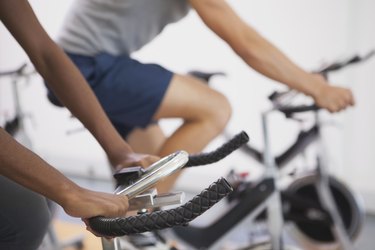
Plantar fasciitis can be painful and interfere with lots of things in your everyday life, including exercise. But as long as it doesn't exacerbate your symptoms of plantar fasciitis, cycling on a stationary bike is an excellent way to maintain fitness.
Tip
Riding a stationary bike is an effective low-impact exercise option when you have plantar fasciitis.
Video of the Day
Symptoms of Plantar Fasciitis
According to the Mayo Clinic, plantar fasciitis is a leading cause of heel pain that results from inflammation of the plantar fascia, a thick band of tissue that connects your toes and heel bone.
Video of the Day
If you have plantar fasciitis, you'll know about it. Characterized by a stabbing pain in the heel when you stand, it's typically worse first thing in the morning and gets better as the day goes on. However, it may worsen after standing for long periods or when standing up after sitting for a while.
Plantar fasciitis is a common overuse injury in runners, according to the Professional Association of Athlete Development Specialists. Being overweight and wearing shoes without proper support are also common causes.
If you're between the ages of 40 to 60, you have an increased risk of plantar fasciitis. Certain foot issues, such as flat feet, high arches or abnormal walking patterns, can also increase your chances, as can being on your feet for long periods.
Read more: The Best Indoor Bikes for At-Home Cycling Workouts
Bike Riding and Plantar Fasciitis
Whatever the cause of your plantar fasciitis, it's important to stay active as much as possible. Mayo Clinic says it can take several months to recover, which is a long time to stay sedentary. The key is finding an activity that doesn't exacerbate or worsen your symptoms.
If you're a runner, you can't run until your condition resolves. If you seek treatment early, the Professional Association of Athlete Development Specialists says this could be as soon as three to five weeks.
In the meantime, follow your doctor's orders. When they give you the go ahead to do any type of exercise, low-impact activities are recommended. Low-impact exercise is anything that doesn't involve repetitive forceful contact between your feet and the ground.
Riding a stationary bike is one of your best options, as your feet don't touch the ground at all. Your heels also don't make contact with the pedals, which will avoid any pressure on that sensitive area of your foot.
The key is to avoid discomfort. As long as you can ride a stationary bike without pain, it is a great exercise to try when you have plantar fasciitis. Other options include using the elliptical machine, rowing, using a hand cycle and swimming, according to NorthShore University Health System.
Read more: 5 Common Workout Injuries and How to Avoid Them
Foot Care Off the Bike
Take it easy with any type of exercise you do while recovering from plantar fasciitis. Now is not the time to train for a century ride. Treat your feet with care on and off the bike.
If your athletic shoes are old and worn out, the Mayo Clinic recommends replacing them so your feet are adequately supported when you ride. If you're experiencing pain and inflammation, check in with your doctor. You can also find relief at home by icing the area for 15 minutes three or four times a day.
Stretching the arches of your feet regularly, including before and after stationary cycling, can also provide relief and improve mobility. The Mayo Clinic recommends stretches that target your plantar fascia, Achilles and calf muscle.
Continue riding a bike and doing other low-impact activities until your doctor or physical therapist says you are ready for higher impact activities. Even then, if you are a runner, consider running less than you previously did to reduce some of the pressure on your feet and prevent another bout of plantar fasciitis and other injuries, recommends Harvard Health Publishing.
Running a few times a week and swimming and biking on the other days is a great way to protect your feet and build well-rounded fitness.
Is this an emergency? If you are experiencing serious medical symptoms, please see the National Library of Medicine’s list of signs you need emergency medical attention or call 911.